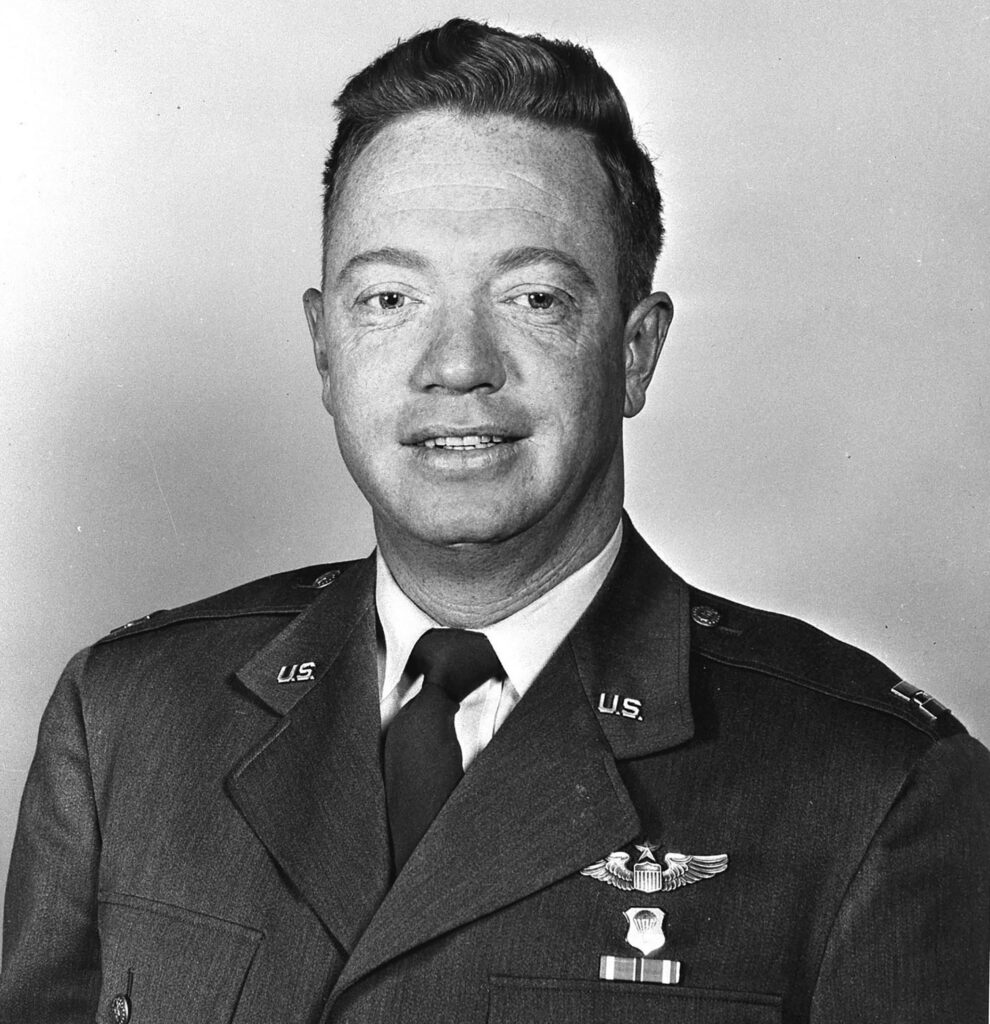
High Flying Pioneer Had Many Connections to Holloman Air Force Base
(Alamogordo, New Mexico, Dec. 9, 2022) – International Space Hall of Fame Inductee Colonel Joe Kittinger has passed away at 94. The New Mexico Museum of Space History staff extends its deepest condolences to his friends and family. Memorial services are being planned for January 2023.
A native of Tampa, Florida, Kittinger became fascinated with planes at a very young age and soloed in a Piper Cub by the time he was 17. After receiving his pilot wings in 1950, he became a NATO test pilot and was later assigned to the Air Force Missile Development Center at Holloman Air Force Base, New Mexico. At Holloman, Captain Kittinger flew experimental jet fighters and participated in aerospace medical research. In December 1954, he flew the T-33 observation plane that monitored the rocket sled experiment of aircraft medicine pioneer Colonel John Paul Stapp in which Stapp traveled 632 miles per hour to test how gravitational stress affected the human body.
In 1955, Dr. Stapp recruited Kittinger as a test pilot for Project Manhigh, which used balloons capable of high-altitude flight and a pressurized gondola (the capsule suspended from the balloon) to study cosmic rays and to determine if humans were physically and psychologically capable of extended travel at space-like altitudes. Kittinger made the first Manhigh ascent on June 2, 1957, in South Saint Paul, Minnesota. He remained aloft for almost seven hours as the balloon climbed to 96,000 feet. Data from his flight and two later Manhigh flights were used in NASA’s Project Mercury.
In 1958, Kittinger was transferred to the Escape Section of the Aeromedical Laboratory at Wright-Patterson Air Development Center’s Aero Medical Laboratory in Dayton, Ohio to become the test director of Project Excelsior, which investigated the use of parachutes for escape from a space capsule or high-altitude aircraft.
On November 16, 1959, Kittinger piloted the Excelsior I balloon to 76,000 feet before returning to Earth by first free falling, and finally, parachuting to the New Mexico desert floor. The jump was almost fatal. His small parachute, which served to stabilize him and prevent him from going into a fatal “flat spin,” opened after only two seconds of free fall, catching Kittinger around the neck and causing him to spiral uncontrollably. Soon he lost consciousness as he tumbled toward the Earth at 120 revolutions per minute. Only his emergency parachute, which opened automatically at 10,000 feet slowed his descent and saved his life.
In spite of his close call, he continued with the project and participated in the flight of Excelsior II, which took place on December 11, 1959. This balloon climbed to 74,700 feet prior to Kittinger jumped from his gondola into a free fall of 55,000 feet before pulling his parachute ripcord.
On August 16, 1960, Kittinger surpassed the altitude record set by Major David Simons, who had climbed to 101,516 feet in the Manhigh II balloon. Kittinger floated to 102,800 feet in Excelsior III. Protected against the subzero temperatures by layers of clothes and a pressure suit, he experienced temperatures as low as minus 94 degrees Fahrenheit. Loaded down with gear that almost doubled his weight, he climbed to his maximum altitude in one hour and 31 minutes, even though at 43,000 feet he began experiencing severe pain in his right hand caused by a failure in his pressure glove and could have scrubbed the mission. He remained at peak altitude for about twelve minutes; then stepped out of his gondola into the darkness of space. After falling for thirteen seconds, Kittinger’s six-foot canopy parachute opened and stabilized his fall, preventing a flat spin, which could have killed him. Only four minutes and 36 seconds more were needed to bring him down to about 17,500 feet where his regular 28-foot parachute opened, allowing Kittinger to float to a safe landing at White Sands Missile Range, New Mexico.
This flight left Joseph Kittinger holding three world records: the highest open-gondola balloon ascent, the longest free-fall, and the longest parachute descent. He may have even broken the sound barrier in free-fall, reaching 714 mph in the rarified atmosphere above 70,000 feet. His records for highest parachute jump and fastest velocity stood for 52 years, until they were broken in 2012 by Felix Baumgartner.
After Excelsior, Kittinger participated in Project Stargazer, a balloon astronomy experiment that studied high-altitude astronomical phenomena from above 95 percent of the Earth’s atmosphere. On December 13 and 14, 1962, Kittinger, along with astronomer William C. White, rose to an altitude of 82,200 feet and hovered over Holloman Air Force Base, in the Stargazer gondola.
Kittinger continued balloon-borne experiments for the Air Force until 1963, when he joined the Air Commando Wing at Hurlburt Field, Florida. He flew 483 missions during three combat tours in Vietnam, two in A-26s and the last as vice commander of an F-4 wing. On May 21, 1972, four days before he was scheduled to go home, Kittinger, a lieutenant colonel and with one Mig-21 to his credit, was shot down over North Vietnam. He spent eleven months as senior officer of the “new guy” POWs (those captured after 1970.).
Colonel Kittinger’s military decorations include the Distinguished Flying Cross for Project Man High and the Distinguished Flying Cross for Project Excelsior. He had numerous civilian awards and was inducted into the International Space Hall of Fame in 1986.
